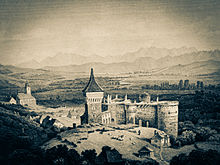Municipalities
| Towns
|
Villages
|
Judetul
Hungedoara
(Romania,
Official)
Hunyad
megye
(Hungarian)
Kreis
Hunedoara
(German)
Hunedoara
(Slovak)
Central
Western Romania,
Southwestern
Transylvania


Borders with Timis
County

Hunedoara as
depicted by
Ludwig Rohbock
(1820-1883)

Hunyad Castle

Skyline of Hunedoara
by Marian Lucian |

Hunedoara
County
is
located
in the
central
west of
the
country
is
crossed
by
rivers
Mures,
Strei,
Raul
Mare,
Cris
White,
Cerna
and Jiu
lakes of
g lacial
origin.
It's
capital
city at
Deva.
The
county
is part
of the
Danube-Kris-Mures-Tisza
Euroregion.
Hunedoara's
Jiu
River
Valley
is
traditionally
a
coal-mining
region,
and its
high
level of
industrialization
drew
many
people
from
other
regions
of
Romania
in the
period
before
the fall
of the
communist
regime.
The name
of the
town
seems
inexorably
linked
to the
name of
the
Hunyadi
family
(also
known as
Corvinus).
The most
probable
explanation
for the
Romanian
name
"Hunedoara"
is the
transliteration
of the
Hungarian
name "Hunyadvár"
meaning
"Castle
of
Hunyad",
as many
Hungarian
towns
have
this
suffix.
Historically,
the name
of the
town has
changed
due to
political
circumstances,
Hungnod
(1265),
Huniad
(1278),
Hwnyadwar
(1409),
Vayda
Hunyadi
(1575).
The
latter
Hungarian
name
Vajdahunyad
(voivode
Hunyad)
is a
direct
referral
to John
Hunyadi.
The
etymology
of the
Hunyadi
family
implies
a Vlach
(Romanian)
origin.
In 1938, the counties of Timiş-Torontal, Caraş, Severin, Arad and Hunedoara were joined to form
Ţinutul Timiş, which encompassed the Romanian Banat.
|
|
|
On 6 September 1950, the province was replaced by the Timişoara Region (formed by the
present-day counties of Timiş and Caraş-Severin).
In 1956, the southern half of the existing Arad Region was incorporated to the Timişoara Region.
In December 1960, the Timişoara Region was named the Banat Region.
On 17 February 1968, a new territorial division was made and today's Timiş, Caraş-Severin and
Arad counties were formed.
Since 1998, Romania has been split into eight development regions, which act as a form of
territorial autonomy divisions. The West development region is composed of four counties: Arad, Timiş,
Hunedoara and Caraş-Severin; thus it has almost same borders as the Timiş Province of
1929. The Vest development region is also a part of the Danube-Kris-Mures-Tisza Euroregion. A
minority of Hungarians make up 5.6% of the population.
The Romanian Banat is mountainous in the south and southeast, while in the north, west and
south-west it is flat and in some places marshy. The climate, except in the marshy parts, is
generally healthy. Wheat, barley, oats, rye, maize, flax, hemp and tobacco are grown in large
quantities, and the products of the vineyards are of a good quality. Game is plentiful and the
rivers swarm with fish. The mineral wealth is great, including copper, tin, lead, zinc, iron and
especially coal. Amongst its numerous mineral springs, the most important are those of Mehadia,
with sulphurous waters, which were already known in the Roman period as the Termae Herculis (Băile
Herculane). The present "Banat Region" of Romania includes some areas that are mountainous and
were not part of the historical Banat or of the Pannonian plain.
Zam
(Hungarian:
Zám;
German:
Sameschdorf)
is a commune
in Hunedoara
County,
Romania. It
is composed
of thirteen
villages:
Almaș-Săliște
(Almásszelistye),
Almășel (Almasel),
Brășeu (Brassó),
Cerbia (Cserbia),
Deleni,
Godinești (Godinesd),
Micănești (Mikanesd),
Pogănești (Poganesd),
Pojoga (Pozsga),
Sălciva (Szolcsva),
Tămășești (Tamasesd),
Valea and
Zam. |
|
MUNICIPALITIES
Brad -
Deva -
capital city
Hunedoara -
German:
Eisenmarkt;
Hungarian:
Vajdahunyad
Lupeni -
Orăștie -
Petroșani -
Vulcan -
TOWNS
Aninoasa
Călan
Geoagiu
Hațeg
Petrila
Simeria
Uricani
VILLAGES
COMMUNES
Baia de Criș
Balșa
Bănița
Baru
Băcia
Băița
Bătrâna
Beriu
Blăjeni
Boșorod
Brănișca
Bretea
Română
Buceș
Bucureșci
Bulzeștii de
Sus
Bunila
Burjuc
Cerbăl
Certeju de
Sus
Cârjiți
Crișcior
Densuș
Dobra
General
Berthelot
Ghelari
Gurasada
Hărău
Ilia
Lăpugiu de
Jos
Lelese
Lunca Cernii
de Jos
Luncoiu de
Jos
Mărtinești
Orăștioara
de Sus
Pestișu Mic
Pui
Rapoltu Mare
Răchitova
Ribița
Râu de Mori
Romos
Sarmizegetusa
Sălașu de
Sus
Sântămăria-Orlea
Șoimuș
Teliucu
Inferior
Tomești
Toplița
Totești
Turdaș
Vața de Jos
Vălișoara
Vețel
Vorța
Zam |
Magyar
Katolikus Lexikon http://lexikon.katolikus.hu/
dicţionar
de localităţi din Transilvania
Wikipedia/en.wikipedia.org
If you
have
additional
information to
contribute
please notify
Jody
McKim.
[Published at
DVHH.org by Jody McKim Pharr]
DVHH.org
©2003
Donauschwaben
Villages
Helping
Hands,
a
Non-profit
Corporation.
Webmaster:
Jody
McKim
Pharr
Keeping
the
Danube
Swabian
legacy
alive!
Last
Updated:
06 Aug 2019
|
|
| |
|